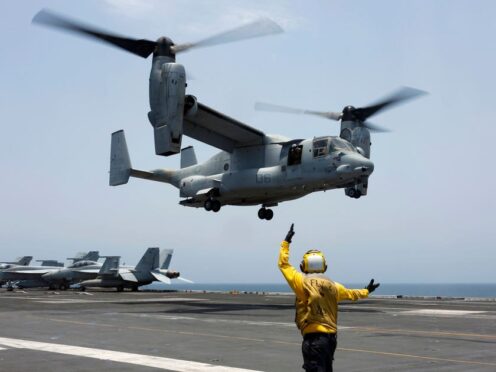
The Osprey, a workhorse aircraft vital to US military missions, has been approved to return to flight after an “unprecedented” part failure led to the deaths of eight service members in a crash in Japan in November, Naval Air Systems Command announced.
The crash was the second fatal accident in months and the fourth in two years. It quickly led to a rare fleet-wide grounding of hundreds of Ospreys across the Marine Corps, Air Force and Navy.
Before clearing the Osprey, which can fly like a plane and then convert to a helicopter, officials said they put increased attention on its proprotor gearbox, instituted new limitations on how it can be flown and added maintenance inspections and requirements that gave them confidence it could safely return to flight.
The entire fleet was grounded on December 6, just a week after eight Air Force Special Operations Command service members were killed when their CV-22B Osprey crashed off Yakushima island.

Officials who briefed reporters on Wednesday ahead of the flight restrictions lifting said that they quickly grounded the entire fleet in December because it became clear that the way the Osprey part failed in that crash was something they had not seen before on the tiltrotor aircraft.
While the officials did not identify the specific component, because the Air Force’s crash investigation is still not completed, they said they now have a better — but not complete — understanding of why it failed.
“This is the first time that we’ve seen this particular component fail in this way. And so this is unprecedented,” said Marine Corps Col Brian Taylor, V-22 joint program manager at Naval Air Systems Command, or Navair, which is responsible for the V-22 programme servicewide.
However, the decision by the Department of Defence to return to flight before separate congressional investigations on the Osprey programme are complete drew criticism from the chair of the House Oversight Committee.
“DoD is lifting the Osprey grounding order despite not providing the Oversight Committee and the American people answers about the safety of this aircraft,” said James Comer, a Kentucky Republican.
“Serious concerns remain, such as accountability measures put in place to prevent crashes, a general lack of transparency, how maintenance and operational upkeep is prioritised, and how DoD assesses risks.”
A former Osprey pilot familiar with the investigation confirmed that the component in question is part of the proprotor gearbox, a critical system that includes gearing and clutches that connect the Osprey’s engine to the rotor to turn it.
The services have done a “deep dive” into the proprotor gearbox, and the new safety measures “will address the issues we saw from that catastrophic event,” the head of Air Force Special Operations Command, Lt Gen Tony Bauernfeind said.
“I have confidence that we know enough now to return to fly,” he said.
The proprotor gearbox system as a whole is a recurring trouble spot for the Osprey.
Service safety data obtained by The Associated Press show dozens of instances among the Marine Corps and Air Force Ospreys in which power surges, sudden loss of oil pressure due to leaks, engine fires or chipping — when the metal components inside the gearbox shed sometimes dangerous metal chips — have damaged the proprotor gearbox in flight, sometimes requiring emergency landings.
Other components of the proprotor gearbox, including the sprag clutch and input quill assembly, have been factors in previous crashes, and the services have made changes, such as replacing those parts on a more frequent basis.

Enjoy the convenience of having The Sunday Post delivered as a digital ePaper straight to your smartphone, tablet or computer.
Subscribe for only £5.49 a month and enjoy all the benefits of the printed paper as a digital replica.
Subscribe